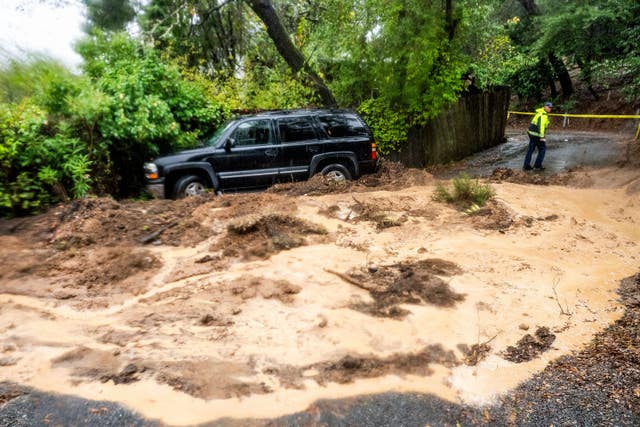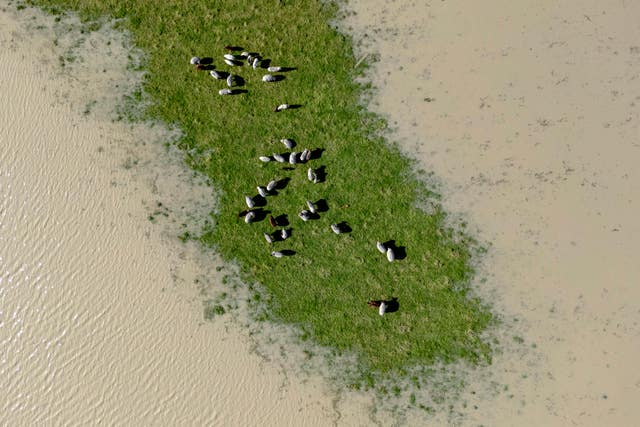
California has been hit by record levels of rainfall, which has caused small landslides and flooding in the US state.
The storm on the west coast of America arrived earlier this week, killing two people and cutting of power to hundreds of thousands, mostly in the Seattle area, before its strong winds moved through northern California.
Santa Rosa, California, saw its wettest three-day period on record with about 12.5 inches of rain falling by Friday evening, according to the National Weather Service in the Bay Area.
Flooding closed part of the Pacific Coast Highway in Mendocino County and there was no estimate for when it would reopen, according to the California Department of Transportation.

Meanwhile, on the east coast, another storm brought much-needed rain to New York and New Jersey, where rare wildfires have raged in recent weeks, and heavy snow to north-eastern Pennsylvania. Parts of West Virginia were under a blizzard warning throughout Saturday morning, with snow and high winds making travel treacherous.
As residents in the Seattle area headed into the weekend, more than 112,000 people were still without power from this season’s strongest atmospheric river – a long plume of moisture that forms over an ocean and flows through the sky over land. Crews worked to clear streets of downed lines, branches and other debris, while cities opened warming centres so people heading into their fourth day without power could get warm food and plug in their mobile phones and other devices.
Gale warnings were issued off Washington, Oregon and California, and high wind warnings were in effect across parts of Northern California and Oregon. There were winter storm warnings for parts of the California Cascades and the Sierra Nevada.
Forecasters predicted that both coasts would begin to see a reprieve from the storms as the system in the north east moves into eastern Canada and the one in the west heads south.
By Friday night, some relief was already being seen in California, where the sheriff’s office in Humboldt County downgraded evacuation orders to warnings for people near the Eel River after forecasters said the waterway would see moderate but not major flooding.

The system roared ashore on the west coast on Tuesday as a “bomb cyclone”, which occurs when a cyclone intensifies rapidly. It unleashed fierce winds that toppled trees onto roads, vehicles and homes.
Debra Campbell said she was sitting in the dark with a torch that night, unable to sleep as strong winds battered her house in Crescent City, California. A 150-foot tree came crashing down on her home and car.
“It was just so incredibly frightening,” Ms Campbell said. “Once I realised it wasn’t going to come through the ceiling where I was at, I was able to grab my car keys and my purse. … And I open the front door and it’s just solid tree.”
In the north east, which has been hit by drought, more than two inches of rain was expected by Saturday morning north of New York City, with snow mixed in at higher elevations.
Despite the mess, the precipitation was expected to help ease drought conditions in a state that has seen an exceptionally dry autumn.
“It’s not going to be a drought buster, but it’s definitely going to help when all this melts,” said Bryan Greenblatt, a National Weather Service meteorologist in Binghamton, New York.
Heavy snow fell in north-eastern Pennsylvania, including the Pocono Mountains, prompting a raft of school closures. Higher elevations reported up to 17 inches, with lesser accumulations in valley cities like Scranton and Wilkes-Barre. More than 85,000 customers in 10 counties lost power, and the state transportation department imposed speed restrictions on some roads.


Why are you making commenting on The Herald only available to subscribers?
It should have been a safe space for informed debate, somewhere for readers to discuss issues around the biggest stories of the day, but all too often the below the line comments on most websites have become bogged down by off-topic discussions and abuse.
heraldscotland.com is tackling this problem by allowing only subscribers to comment.
We are doing this to improve the experience for our loyal readers and we believe it will reduce the ability of trolls and troublemakers, who occasionally find their way onto our site, to abuse our journalists and readers. We also hope it will help the comments section fulfil its promise as a part of Scotland's conversation with itself.
We are lucky at The Herald. We are read by an informed, educated readership who can add their knowledge and insights to our stories.
That is invaluable.
We are making the subscriber-only change to support our valued readers, who tell us they don't want the site cluttered up with irrelevant comments, untruths and abuse.
In the past, the journalist’s job was to collect and distribute information to the audience. Technology means that readers can shape a discussion. We look forward to hearing from you on heraldscotland.com
Comments & Moderation
Readers’ comments: You are personally liable for the content of any comments you upload to this website, so please act responsibly. We do not pre-moderate or monitor readers’ comments appearing on our websites, but we do post-moderate in response to complaints we receive or otherwise when a potential problem comes to our attention. You can make a complaint by using the ‘report this post’ link . We may then apply our discretion under the user terms to amend or delete comments.
Post moderation is undertaken full-time 9am-6pm on weekdays, and on a part-time basis outwith those hours.
Read the rules here